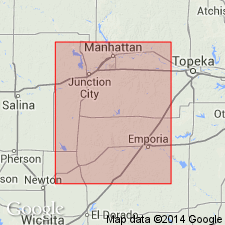
- Usage in publication:
-
- Strong flint
- Modifications:
-
- Named
- Dominant lithology:
-
- Limestone
- Shale
- AAPG geologic province:
-
- Nemaha anticline
Summary:
Is lowest of three flint horizons recognized in Chase formation (new). Named as basal unranked unit of Chase in Chase Co, KS (Nemaha anticline). "In the Cottonwood Valley...caps the Crusher Hill west of Strong City, and...called the Strong flint, which varies in thickness from 35 to 45 feet." Described as: "two strata of light gray limestone containing an abundance of flint layers, separated by a massive whitish limestone" and characteristic fossils listed (table, p. 799). Complete section comprised of five units described two mi northeast of Council Grove (ascending): 7 1/2 ft, light-gray limestone with plenty of flint in regular layers; 18 ft, massive light-gray to whitish limestones with some flint; 3 1/2 ft, yellowish and rather coarse shale; 10? ft, limestone with abundant coarse flint and some large brown concretions; 3+/-ft, massive gray limestone. Comprises beds No. 62-58 of Swallow (1866); corresponds to bed No. 18 of Meek and Hayden (1859); and "is No. 5 of Hay's (1893, p. 104) section, which he termed 'the lower flint beds' or the 'Wreford limestone.'" Is assigned to the Permian series of the Carboniferous period (table, p. 799). Overlies Neosho formation (new); overlain by unnamed lower part of Chase formation.
Source: GNU records (USGS DDS-6; Denver GNULEX).
For more information, please contact Nancy Stamm, Geologic Names Committee Secretary.
Asterisk (*) indicates published by U.S. Geological Survey authors.
"No current usage" (†) implies that a name has been abandoned or has fallen into disuse. Former usage and, if known, replacement name given in parentheses ( ).
Slash (/) indicates name conflicts with nomenclatural guidelines (CSN, 1933; ACSN, 1961, 1970; NACSN, 1983, 2005, 2021). May be explained within brackets ([ ]).

